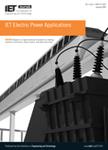版权所有:内蒙古大学图书馆 技术提供:维普资讯• 智图
内蒙古自治区呼和浩特市赛罕区大学西街235号 邮编: 010021

作者机构:Anhui Univ Sch Elect Engn & Automat Hefei Peoples R China Anhui Univ Natl Engn Lab Energy Saving Motor & Control Techn Hefei Peoples R China Anhui Univ Anhui Prov Lab Elect Economize & Safety Hefei Peoples R China Anhui Univ Collaborat Innovat Ctr Ind Energy Saving & Power Hefei Peoples R China Anhui Univ Sch Internet Hefei Peoples R China
出 版 物:《IET ELECTRIC POWER APPLICATIONS》 (IET电力应用)
年 卷 期:2021年第15卷第8期
页 面:1045-1055页
核心收录:
基 金:Key Project of the China National Natural Science Foundation National Natural Science Foundation of China
主 题:Spatial variables control COMSOL Multiphysics nonlinear friction friction PMSpM jitter parameter identification method friction data Control of electric power systems Numerical analysis dynamics model permanent-magnet spherical motor Lagrangian energy method rotor support mandrels Mechanical components friction torque data closed loop systems Tribology (mechanical engineering) Mechanical variables control friction torque field distribution Coulomb friction model torque permanent magnet motors friction torque compensation machine control system operation accuracy multiphysical field position control finite element analysis parameter estimation rotors torque control
摘 要:Non-linear friction between the rotor and the rotor support mandrels would occur during the movement of the permanent-magnet spherical motor (PMSpM). The friction which varies with the position causes PMSpM jitter or even stop it when running at low speeds, and the system operation accuracy is reduced. To solve these problems, this work proposes a parameter identification method of the Coulomb friction model. First, a dynamics model with the Coulomb friction of PMSpM is established by using generalised Euler angles and the Lagrangian energy method. Then, a parameter identification method of the Coulomb friction model based on COMSOL Multi physics coupled simulation and MEMS experiment is proposed to obtain the friction torque data of the PMSpM. Finally, the friction torque compensation in a closed-loop control experiment is completed by using the friction data. The results show that the accuracy of trajectory tracking control is significant, and the error is reduced by 49.32%. Hence, the distribution of the friction torque field is accurate and effective.